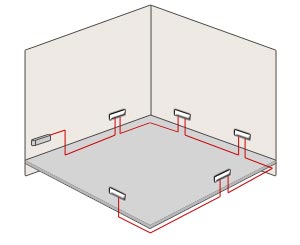Domestic Electrical Circuits
Introduction
There are three types of domestic circuit:
- Ring mains and radial circuits, which provide sockets and fused connection units for plugs and appliances.
- Lighting circuits allow for overhead lighting.
Ring mains
Ring circuits or ring mains are the most commonly used method of installing sockets in a home, usually with one circuit per floor of the property.
They are arranged in the form of a continuous loop of two-core-and-earth cable that runs through the walls from the consumer unit, all round the footprint of the house, and returns to the same terminal in the consumer unit.

Sockets are positioned along the route of the cable and power can be carried to them in either direction round the loop, thereby reducing the load on the cable.
- Ring circuits are always installed with 2.5mm² two-core-and-earth cable and protected by a 30amp cartridge fuse or 32amp MCB.
IEE Wiring Regulations stipulate that a single ring main may not serve an area larger than 100m² (1076 sq ft) and that maximum cable lengths are observed. If using a 30amp cartridge fuse, no more than 60m of cable can be used, if using a 32amp MCB, no more than 50m of cable can be used.
Radial circuits
These are more old-fashioned than ring circuits, and differ from them in that the cable travelling through each socket does not return to the consumer unit; it simply terminates at the last power outlet. Because power has to travel through these circuits in one direction only, they can only serve smaller areas.

Radial circuits may be installed in two ways:
A circuit using 2.5mm² two-core-and-earth cable must be protected by a 20amp fuse or MCB, and serve an area no greater than 50m² (538 sq ft).
- Maximum cable lengths of 33m if protected by an MCB, or 35m if protected by a cartridge fuse apply.
A circuit using 4.0 mm² two-core-and-earth cable must be protected by a 30amp cartridge fuse or 32amp MCB, and serve an area no greater than 75m² (807 sq ft).
- Maximum cable lengths of 33m if protected by an MCB, or 38m if protected by a cartridge fuse apply. Note that a rewirable fuse is not permitted in this scenario.
Spurs
These are additional, short branch extensions to a ring main or radial circuit.
A single length of 2.5mm² two-core-and-earth cable serves one additional power outlet (single or double socket), connecting it to the circuit either via an existing socket or using a junction box inserted into the existing cable run.

- When adding spurs to a ring main, the total number of additional power outlets must not exceed the original number of sockets on the circuit (ie. if the circuit had 4 power outlets, no more than 4 additional ones can be installed), and the total circuit must adhere to area and cable length restrictions.
- There is no limit to the number of spurs that can be added to a radial circuit, provided that limits on area served and total cable length are observed.
When adding spurs to circuits, remember that lengths of cable must be set into walls in horizontal and vertical lines only ie. no diagonal paths can be taken.
The NHBC (National House-Building Council) recommend the following number of power outlets, although Building Regulations stipulate less:
- 6 in a kitchen or utility room
- 4 + TV coaxial outlet in living room
- 2 in a dining room
- 3 in master bedroom
- 2 in other bedrooms
- 1 in each hall and landing
Lighting circuits
These are basically multi-point radial circuits that can take two forms, and are often a combination of both of these:
Loop-in lighting circuits have a cable that runs from the consumer unit and out to several ceiling roses which directly link to each lighting pendant and its switch.

The more old fashioned junction box circuits use junction boxes positioned on the main cable to distribute power to a lighting pendant and has a separate connection to each light switch. The latter is often used when adding lighting points to an existing circuit.
- Lighting circuits should be installed using 1.5mm² two-core-and earth cable protected by a 5amp fuse or 6amp MCB.
Three-core-and-earth cable should be used to install two-way light switches in areas such as staircases.
Such circuits are designed to support no more than eleven 100W bulbs, or a maximum of 1100W.
Further information and useful links
- Find an Electrical Merchants near you
- Find an Electrical Re-Wiring Specialist near you
- Find an Electrician near you
Site Pages
Featured Articles





